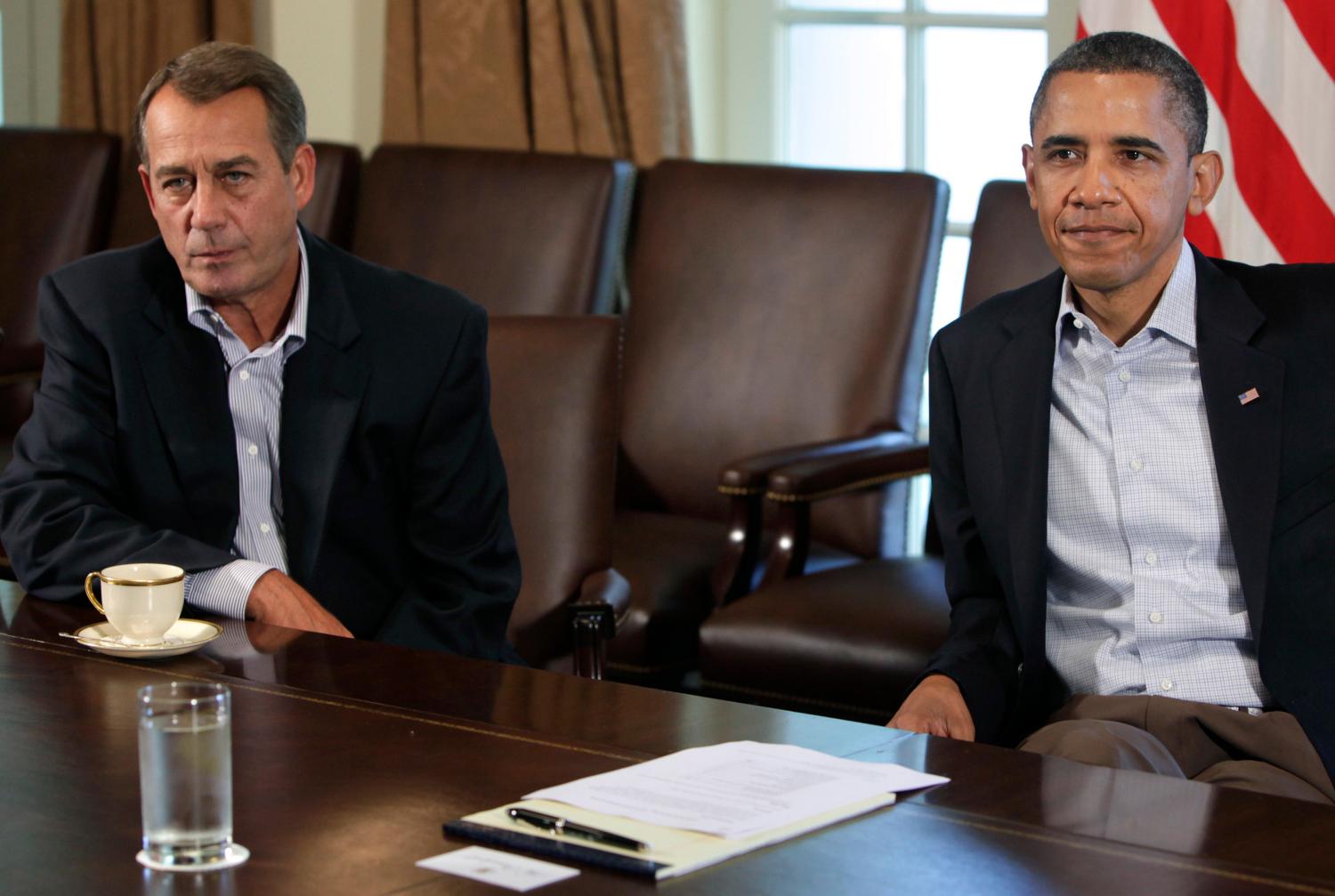- Molly E. Reynolds
- Philip A. Wallach
- See More
More On
The Republican takeover of the House of Representatives in the 2010 elections touched off a series of budgetary battles between the White House and congressional Republicans that would rage on for the rest President Obama’s presidency. These “fiscal fights” included:
- Arguments over how federal resources should be raised and spent, including debates over tax cuts, sequestration, and government shutdowns (labeled “Fiscal”)
- Disagreements over whether to raise the debt ceiling (labeled “Debt Ceiling”)
- Clashes that brought both sets of conflicts together, as when Republicans used the debt ceiling to demand fiscal cuts, leading to the Budget Control Act of 2011 (labeled “Debt/Fiscal”)
We recap these important fiscal fights that did so much to define American politics over the last six years in the timeline below.
2011Spring 2011 Continuing Resolutions
March 1 – April 15, 2011Between March 1 and April 15, Congress approves four continuing resolutions, the last funding the government through September 2011 and approved just hours before a partial government shutdown would have begun. These CRs represented the new House Republican majority’s first attempt at fiscal policymaking during the Obama presidency. House conservatives’ hardline position on spending cuts foreshadowed the challenges to come during the debt ceiling debate in the summer.
Further Reading
Summer 2011 Debt Ceiling Showdown
May 16 – August 2, 2011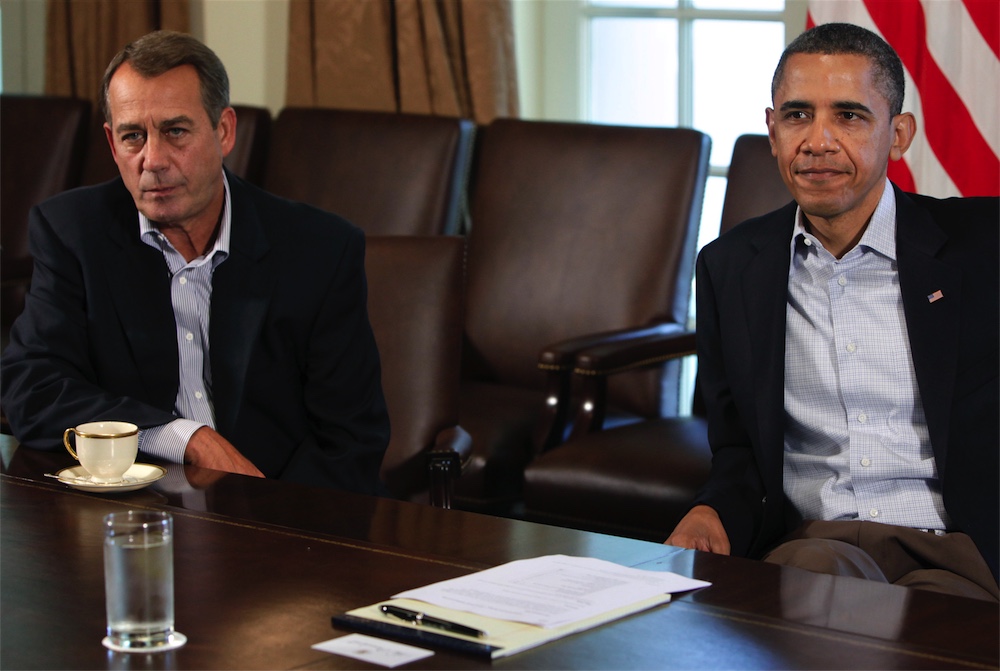
The debt ceiling, last raised in February 2010, is reached on May 16, leading Treasury to employ its familiar “extraordinary measures” for operating funds. Secretary Geithner says these tactics will be exhausted by August 2. Republicans insist on the so-called “Boehner Rule,” in which debt ceiling increases would be matched, dollar-for-dollar, by spending reductions in the 10-year budget window. Ambitious and acrimonious negotiations involving Obama, Biden, Reid, Boehner, Cantor, and McConnell fail repeatedly to produce a “grand bargain” or even an acceptable compromise.
Further Reading
A Sword of Damocles for the Debt CeilingAlice M. Rivlin and Pete Domenici Debt Ceiling: Why President Obama Should Seek an Interim AgreementWilliam A. Galston The Procedural Side of Senator Mitch McConnell’s Debt Ceiling FixSarah A. Binder Around the Halls: Forging a Compromise on the Debt LimitWilliam G. Gale, et al.
Budget Control Act of 2011 Enacted
August 2, 2011
Right at the debt ceiling deadline, a complicated agreement is reached that will allow for three debt ceiling increases totaling $2.1 trillion. The legislation places caps on the level of funding permitted through the annual appropriations process for the next ten years and creates a Joint Select Committee on Deficit Reduction (“Supercommittee”), charged with identifying an additional $1.5 trillion in deficit reduction, with across-the-board sequestration as a backup if it fails.
Further Reading
Congressional Super Committees: How Super Are They in Resolving the Budget Deficit Debate?Sarah A. Binder The Republicans Are Winning, but Is the Country?Isabel V. Sawhill Web Chat: Winners and Losers in the Federal Budget and Debt DebateDarrell M. West Around the Halls: The Debt Limit Clock Runs OutIsabel V. Sawhill, et al.
Joint Select Committee on Deficit Reduction Meets
September – November 2011The “Supercomittee,” comprised of three Democrats and three Republicans from each chamber of Congress, was tasked by the Budget Control Act with developing a proposal to reduce the deficit by $1.5 trillion over ten years. On November 21, members announce they have failed to do so. As a result, sequestration, or across-the-board cuts to both defense and non-defense programs, is scheduled to go into effect on January 1, 2013.
Further Reading
What Happens if the Super Committee Fails?Isabel V. Sawhill The Super Committee: Less Important Than Meets The EyeHenry J. Aaron Web Chat: Congressional Super Committee Unable to Find CompromiseRon Haskins The Super Committee’s Failure and Its Effect on Low-Income FamiliesRon Haskins
2012Fiscal Cliff Negotiations
December 2012
During the lame duck session after President Obama’s reelection, Congress confronts the looming imposition of sequestration, the expiration of the (2010 extended) Bush tax cuts, the ballooning of the alternative minimum tax, and the annual need for a doc fix. The contractionary effects of all these changes on the still-fragile economy is widely feared. The debt ceiling is also expected to be hit (forcing use of extraordinary measures) on December 31.
Further Reading
The 2013 Budget: A Process Run AmokBill Frenzel Forget the Fiscal Cliff; Focus on the Debt CeilingIsabel V. Sawhill The Debate over the Fiscal Cliff and Tax Cuts: A Live Web Chat with Ron HaskinsRon Haskins
2013American Taxpayer Relief Act of 2012 Enacted
January 3, 2013The culmination of the December “fiscal cliff” negotiations, ATRA permanently extended a set of tax cuts and credits originally enacted in 2001 and 2003 and, as a result, prevented large tax increases for most Americans. Legislation also reduces initial set of across-the-board military and domestic spending cuts required by BCA from $109 billion to $85 billion and postpones them from January 1 to March 1.
Further Reading
A Fiscal Cliff Compromise Through Alternative CPI?Henry J. Aaron The Fiscal Cliff Has Been Avoided, But at What Cost?William G. Gale The Fiscal Cliff Deal and Our Long-Run Budget ChallengeMichael Greenstone, et al. The Fiscal Cliff Deal: The Benefits of Politics as UsualJohn Hudak
Debt Ceiling Suspended
February 4, 2013After the fiscal cliff deal failed to address the debt ceiling, forcing the Treasury to again resort to extraordinary measures at the start of 2013, The No Budget, No Pay Act of 2013 suspends the debt ceiling through May 18, 2013 and postpones another major showdown. Congress hoped to make it so legislators would not get paid if they failed to pass required budgets, but conflicts with the 27th Amendment mean that pay would actually only be postponed.
Further Reading
Where Is the Urgency on the Debt Ceiling?Henry J. Aaron Mr. Boehner, Tear Down This Debt Ceiling!Philip A. Wallach Republicans’ leverage from debt ceiling vastly overratedPhilip A. Wallach, The Hill
Sequestration Takes Effect
March 1, 2013
$85 billion in across-the-board spending cuts to both defense and non-defense federal programs take effect. Notable reductions include $42 billion from the defense budget and $11 billion from Medicare. Select programs, including Medicaid, Social Security, Temporary Assistance to Needy Families, and food stamps, are exempt from cuts.
Further Reading
Preparing for Sequestration: What to ExpectMichael E. O’Hanlon and William A. Galston Five Myths About the SequesterThomas E. Mann and Norman J. Ornstein The Perils of Automatic BudgetingPhilip A. Wallach, National Affairs
Continuing Resolution Enacted
March 26, 2013Congress avoids a partial government shutdown by adopting a measure to fund the government through September 30. Bill does not suspend the across-the-board spending cuts implemented on March 1, but does provided targeted relief in several specific areas, including short-term defense needs, Head Start, and food processing inspectors. Those increases are offset by cuts elsewhere, including at the Department of Energy and the TSA.
Further Reading
Short-Term Congressional Budget Fixes Only Prevent Total DisasterBill Frenzel Sequestration, Political Settlement, and Effective GovernmentPhilip A. Wallach The Federal Government Shutdown: A Marriage Of Bad Policy And Toxic EconomicsDouglas J. Elliott The Federal Budget in 2013: Dysfunction RevisitedRomina Boccia and Michael Sargent, The Heritage Foundation
Debt Ceiling Reinstated
May 19, 2013The debt ceiling suspension agreed to in February expires, bringing the debt ceiling back into effect at the current level of outstanding debt. Extraordinary measures once again begun, originally predicted to last into late summer and later expected to last through October 17.
Further Reading
Economic Studies Experts On the Government Shutdown and Debt Ceiling StandoffDouglas J. Elliot, et al. It’s Groundhog Day Over the Debt CeilingWilliam G. Gale Transcript: Exclusive Interview With House Speaker John Boehner on NSA Leak, Immigration Reform And MoreABC News
Government Shutdown Begins
October 1, 2013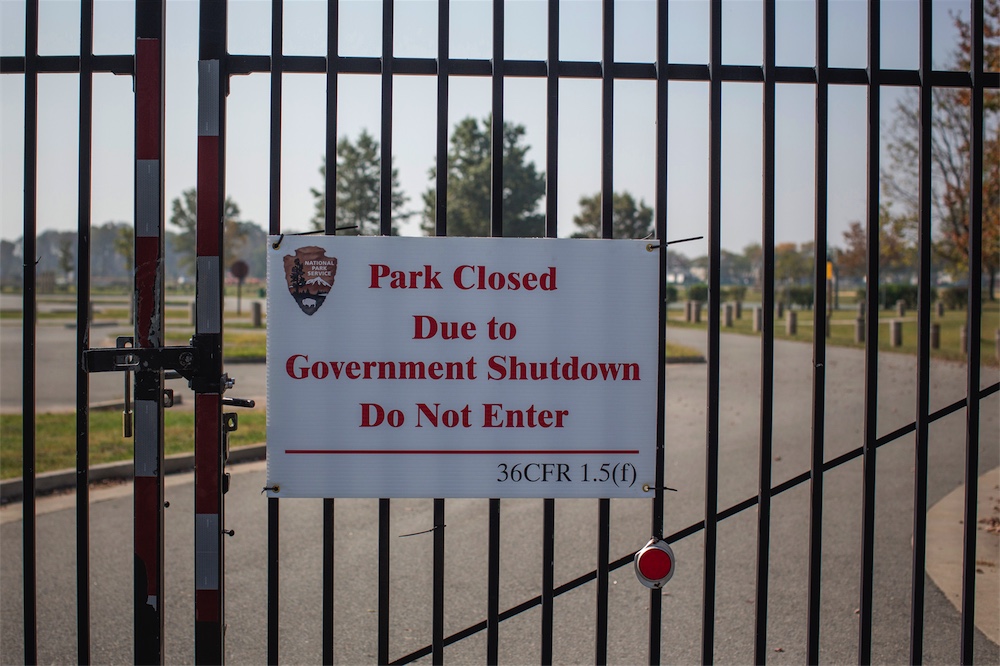
House (controlled by Republicans) and Senate (controlled by Democrats) fail to reach agreement on a measure to avoid a partial government shutdown, affecting roughly 40 percent of the civilian federal workforce. Principal disagreement involves demands by conservative Republicans, led by Senator Ted Cruz (R-TX), that any spending bill repeal or significantly delay key components of the Affordable Care Act.
Further Reading
History Rhymes on Debt CeilingPhilip A. Wallach Today’s Budget Impasse Is Much More Dangerous Than ’95Alice M. Rivlin What’s in a Deal? Possible Solutions to Shutdown and Default CrisesPhilip A. Wallach and William A. Galston To Fix the Debt Ceiling, Executive Order not Obama’s Best OptionPhilip A. Wallach
Government Shutdown Ends and Debt Ceiling Suspended
October 16, 2013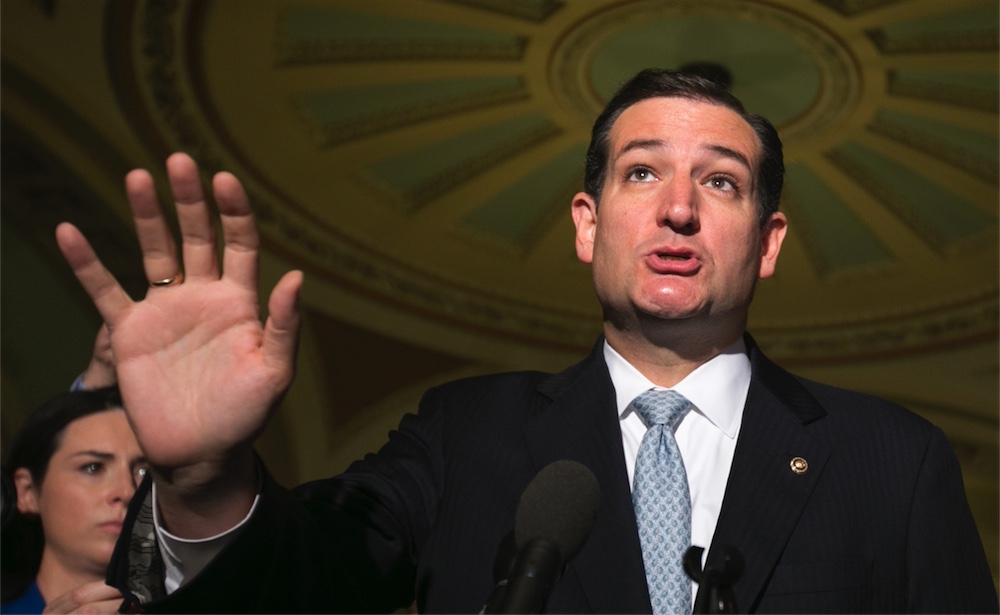
After a 16-day partial shutdown, and just a day ahead of the debt ceiling deadline announced by Treasury, Congress passes continuing resolution funding discretionary federal programs through January 15, 2014. A majority of House Republicans oppose the bill, which does not reflect Republicans’ demands for changes to implementation of the Affordable Care Act. The debt ceiling is again suspended, this time through February 7, 2014.
Further Reading
The Budget Crisis Is Over (Temporarily), But Another Is Coming SoonBill Frenzel Lessons from the Shutdown: Alternatives to the Debt CeilingPhilip A. Wallach Lessons from the Shutdown: Consequences for Attacking the Federal WorkforceJohn Hudak Deal-making in a polarized CongressSarah A. Binder, Washington Post
Bipartisan Budget Act of 2013 Enacted
December 26, 2013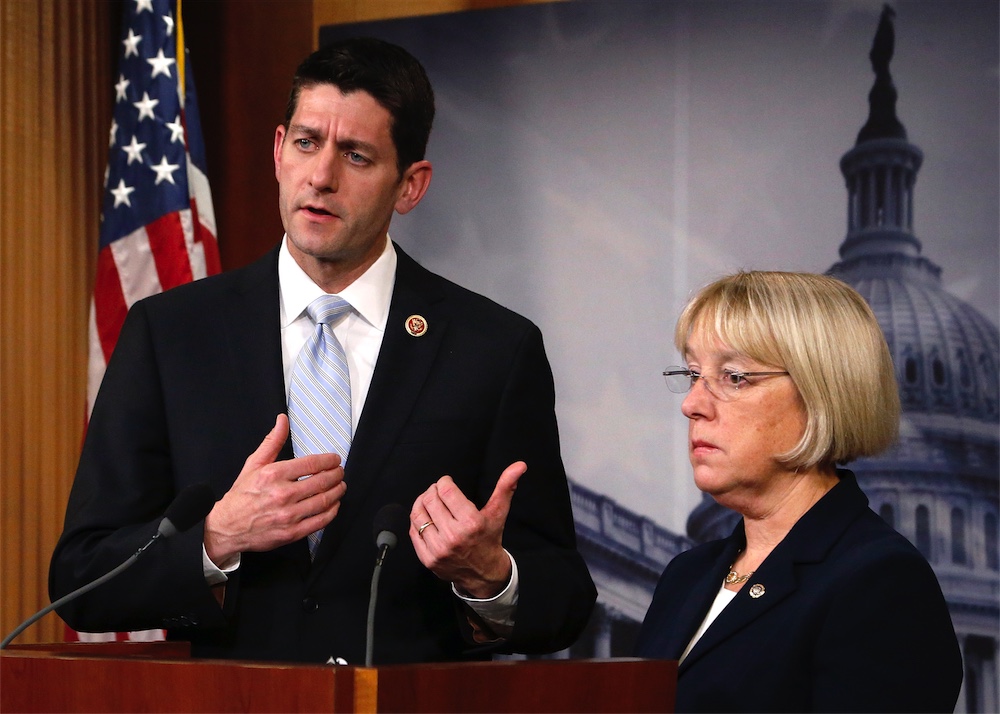
After negotiations led by House Budget Committee Chair Paul Ryan (R-WI) and Senate Budget Committee Chair Patty Murray (D-WA), Congress passes legislation relaxing BCA caps by equal amounts for both defense and non-defense spending through September 30, 2015. Increases in allowable spending are offset by additional cuts to Medicare providers, higher fees on airline tickets, and increases in required contributions by federal workers to their pensions.
Further Reading
Yes, There’s Hope for a Big Budget DealAlice M. Rivlin and Pete Domenici Don’t Be So Quick To Dismiss The Paul Ryan-Patty Murray Budget DealBill Frenzel Profiles in negotiation: The Murray-Ryan budget dealJill Lawrence What the emerging budget deal means (and doesn’t mean) for CongressSarah Binder, The Washington Post
2014Congress Steers Clear of Debt Ceiling Fight Reprise
February 15, 2014The debt ceiling was reinstated on February 7, 2014, with Treasury Secretary Lew announcing that extraordinary measures would be exhausted by the end of the month. Now wary of another debt ceiling showdown, House Republicans decide to extend the debt ceiling suspension until March 16, 2015, passing the Temporary Debt Limit Extension Act. With Senate Republicans opposed, it was unclear if 60 votes could be found until Minority Leader McConnell threw his support to the measure, which then received 67 votes and was quickly signed by the President.
Further Reading
Once More Unto the Breach… of the Still-Useless Debt CeilingPhilip A. Wallach Breaking Down the Debt Ceiling VoteMatt Fuller, Roll Call House Approves Higher Debt Limit Without ConditionJonathan Weisman and Ashley Parker, The New York Times Updated Q&A: Everything You Should Know About the Debt CeilingCommittee for a Responsible Federal Budget
Continuing Resolution Enacted
September 19, 2014Eager to avoid the possibility of a partial government shutdown ahead of the 2014 midterms, Congress clears a temporary spending bill. The bill is nearly sidelined in the Senate by an effort, led by Senators Ted Cruz (R-TX) and Jeff Sessions (R-AL), to allow for additional amendments related to President Obama’s executive action on immigration, providing a preview of a conflict to come in December.
Further Reading
Congress Is in a Unique Position to Actually Pass LegislationGrace Wallack What’s a Continuing Resolution and Why Does It Matter?Tanya Somander, The White House Blog Senate Votes to Fund Syrian Rebels Against ISIS, Avert Government ShutdowNiels Lesniewski, Roll Call
“CROmnibus” Appropriations Bill Enacted
December 16, 2014Congress avoids partial government shutdown by adopting the “CROmnibus,” a combination continuing resolution (CR) and omnibus appropriations bill. The CR provides temporary funding for the Department of Homeland Security until February 2015–providing for an additional attempt to block President Obama’s executive action on immigration under unified Republican congressional control after the start of the new congress. The omnibus bill provides funding for all other discretionary programs through September 2015.
Further Reading
Congress Kicks the Can Down the Road: Chapter 100Ron Haskins What’s in the spending bill? We skim it so you don’t have toEd O’Keefe, The Washington Post
2015DHS Shutdown Averted
February 28 – March 3, 2015
Just before the continuing resolution funding the Department in Homeland Security adopted in December 2014 expires, the House rejects a three-week extension after 50 House Republicans vote against a measure backed by their leadership. A one-week extension is approved, and on March 3, Congress funds the agency through September without additional restrictions on the implementation of President Obama’s executive action on immigration.
Further Reading
DHS shutdown? Hand it over to Senator Murray and Congressman RyanElaine Kamarck DHS shutdown: ‘There’s an opportunity cost’Mark Rockwell, FCW What a DHS Shutdown Would Look LikeLazaro Zamora, Bipartisan Policy Center
Debt Ceiling Reinstated
March 16, 2015The debt ceiling comes back into effect after the February 2014 extension of the suspension expires. Extraordinary measures are at first predicted to last into late summer, and later until November 5.
Further Reading
The debt ceiling, yet againPhilip A. Wallach Extraordinary Measures, SimplifiedBipartisan Policy Center Q&A: Everything You Should Know About the Debt CeilingCommittee for a Responsible Federal Budget
Speaker of the House Announces Resignation
September 25, 2015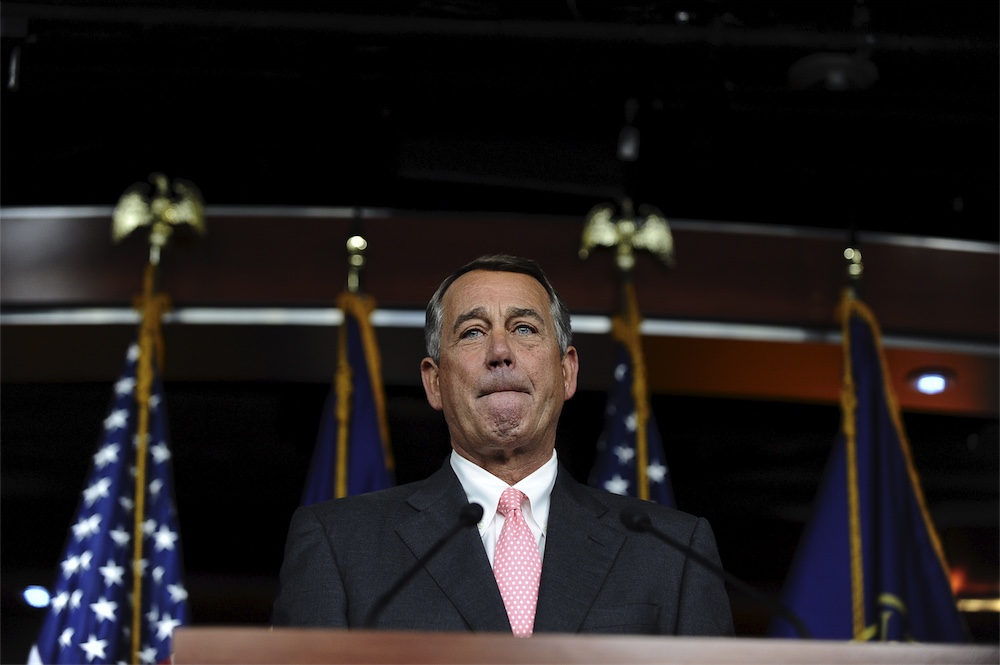
Speaker of the House John Boehner (R-Ohio) announces that he will resign at the end of October, the first Speaker to do so in 30 years. His decision is partially motivated by repeated fiscal fights within the House Republican Conference, including an effort led by members of the House Freedom Caucus to depose him if he did not push for a short-term spending bill that eliminated federal funding for Planned Parenthood. Boehner makes clear his desire to “clean the barns” before his departure.
Further Reading
Speaker Boehner’s Reagan conservatism wasn’t enough for today’s GOPThomas E. Mann Does Speaker Boehner’s resignation reduce the likelihood of a government shutdown?Molly E. Reynolds An open letter to Speaker John Boehner regarding the debt ceilingPhilip A. Wallach
Continuing Resolution Enacted
September 30, 2015Congress avoids partial government shutdown by adopting a continuing resolution that lasts until December 11. All votes against the measure (91 in the House and 20 in the Senate) come from Republicans, reflecting the continued divisions within the party about the best approach to fiscal policy with a Democratic president in the White House.
Further Reading
The budget showdown: How did we get here?Molly E. Reynolds The budget showdown: How do we get there from here?Molly E. Reynolds Full-Year Continuing Resolution Would Miss Chance for Sequestration ReliefDavid Reich, Center on Budget and Policy Priorities Overview of the FY2016 Continuing Resolution (H.R. 719)Jessica Tollestrup, Congressional Research Service
Bipartisan Budget Act of 2015 Enacted
November 2, 2015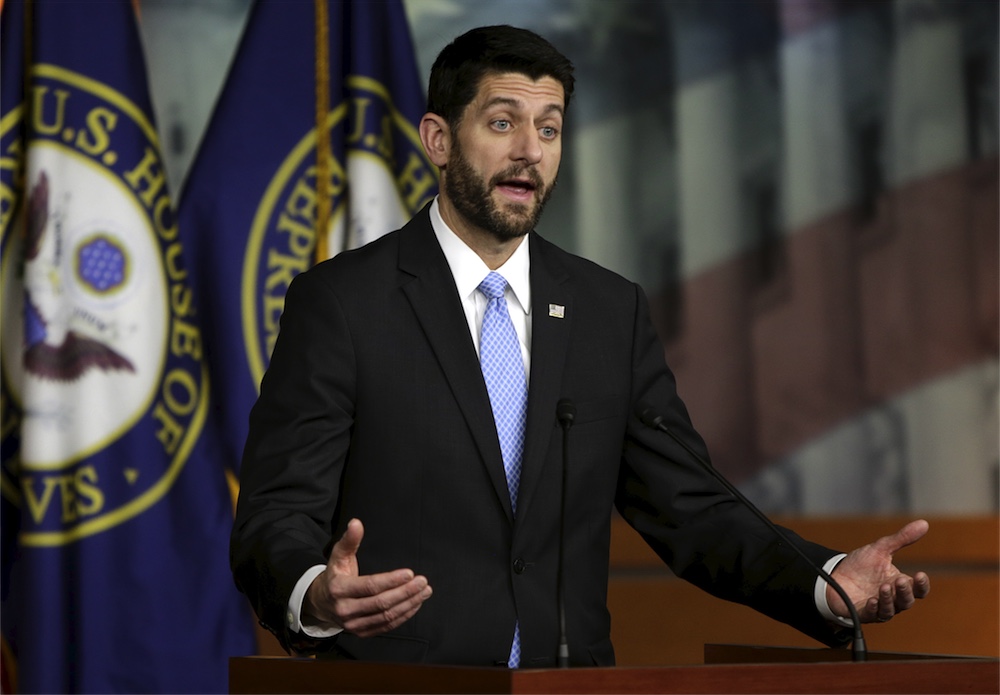
Negotiated by departing Speaker of the House John Boehner (R-Ohio), the legislation increases BCA spending caps equally for defense and non-defense programs for two years ($25 billion for 2016 and $15 billion for 2017). It also suspends the debt ceiling through March 16, 2017, ensuring that there will be no more debt ceiling confrontations during the Obama administration.
Further Reading
Five things to know about the budget dealMolly E. Reynolds Who are the House Republicans that sealed the debt deal?”Five things to know about the budget deal?Molly E. Reynolds Here are four (and a half) takeaways from the new budget dealSarah Binder, The Washington Post The Debt-Ceiling CircusPhilip A. Wallach, US News
Omnibus Appropriations Bill Enacted
December 16, 2015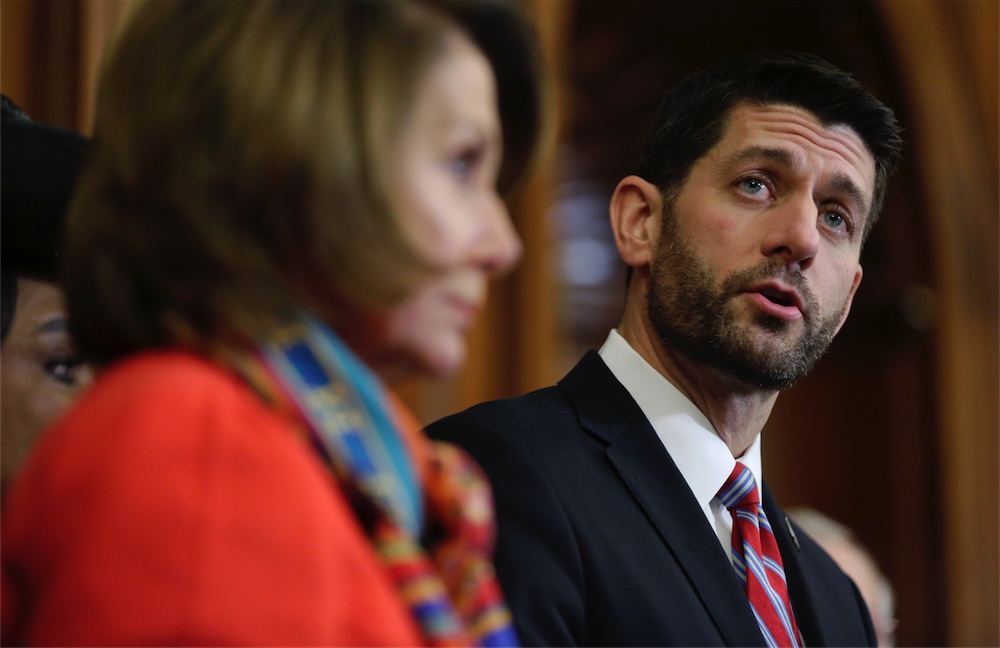
Congress passes, and the president signs, a bill containing $1.1 trillion in spending for the rest of fiscal year 2016 and $650 billion in tax cuts. Seen as a “half-baked cake” left over from the situation set up by former Speaker John Boehner (R-Ohio), the bill passes with the support of a majority of House Republicans (150 of 246) in an early victory for new Speaker of the House Paul Ryan (R-Wisc.).
Further Reading
Grading Ryan’s first omnibusMolly E. Reynolds Restoring regular order in congressional appropriationsPeter C. Hanson Congress Passes $1.8 Trillion Spending MeasureDavid M. Herszenhorn, The New York Times
2016House Considers Appropriations Bills Without Budget Resolution
May 2016For the first time since the creation of the modern congressional budget process in 1974, the House begins considering appropriations bills without first adopting a budget resolution or an equivalent measure establishing a high-level budget framework for the new fiscal year. This approach results from conflict within the House Republican Conference and the refusal of some members to support a budget resolution that reflects the October 2015 budget deal.
Further Reading
Three budget fights to watchMolly E. Reynolds Fights loom over appropriations in the House and SenateMolly E. Reynolds Speaker Ryan meets the realities of governingMolly E. Reynolds Is the Freedom Caucus still a formidable foe in 2016?Molly E. Reynolds Unusual AppropriationsMark Harkins, The Government Affairs Institute at Georgetown University
Continuing Resolution Enacted
September 29, 2016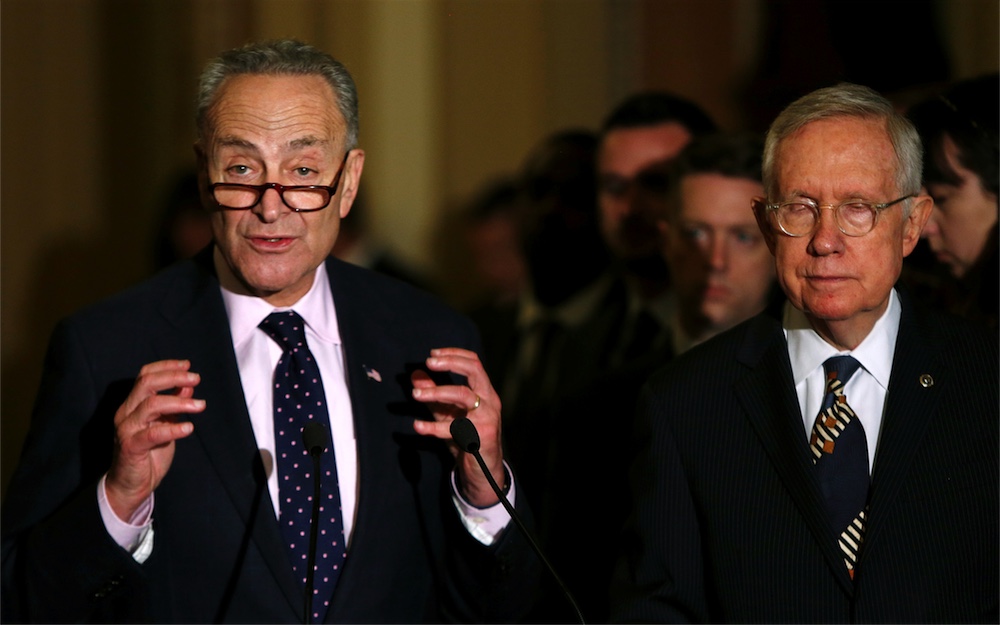
Congress narrowly avoids a partial government shutdown by adopting a measure to fund the government through December 9; the bill also includes full year funding for military construction and the Department of Veterans’ Affairs. Final deal hinges on resolution of two main sticking points: a proposed prohibition on funds to fight the Zika outbreak in Puerto Rico going to Planned Parenthood and the inclusion of funds to address the Flint, MI water crisis.
Further Reading
What emergency Zika funding tells us about congressional dysfunctionMolly E. Reynolds What Congress Has, and Hasn’t, Accomplished on Spending LegislationMolly E. Reynolds Congress: Four things to watch in the next four weeksMolly E. Reynolds Appropriations Watch: FY 2017Committee for a Responsible Federal Budget
Final Continuing Resolution of the Obama Administration
December 2016With unified Republican control of Congress and the White House on the horizon for the first time in a decade, the House and Senate opt to punt the remainder of their appropriations work for fiscal year 2017 again, this time until the end of April. The later spring date gives the new administration the opportunity to weigh in on spending priorities while also accommodating a potentially busy congressional agenda—including Senate action on cabinet nominations—in early 2017. Conflict over the length of an extension of benefits for coal miners prolongs debate in the Senate, threatening a brief government shutdown
Further Reading
- 2017
Supplemental resources
Brookings Content
- Douglas W. Elmendorf, “Recommendations for federal budget policy,” October 7, 2016
- Alice M. Rivlin and Pete V. Domenici, “Proposal for improving the congressional budget process,” July 2015
- Philip A. Wallach, “Minimizing debt ceiling crises: Principles and practical advice,” October 2015
- David Wessel, “Why we made a computer game about the federal budget,” April 26, 2016
Non-Brookings Content
- Robert Draper, When the Tea Party Came to Town (New York, NY: Simon & Schuster, 2012)
- Bob Woodward, The Price of Politics (New York, NY: Simon & Schuster, 2013)
- “A Glossary of Terms Used in the Federal Budget Process,” GAO, September 2005
- James V. Saturno, “The Congressional Budget Process: A Brief Overview,” CRS, August 22, 2011
- Bill Heniff Jr., Megan Suzanne Lynch, and Jessica Tollestrup, “Introduction to the Federal Budget Process,” CRS, December 3, 2012
- Clinton T. Brass., “Shutdown of the Federal Government: Causes, Processes, and Effects,” CRS, September 8, 2014
- Jessica Tollestrup, “The Congressional Appropriations Process: An Introduction,” CRS, November 14, 2014
- D. Andrew Austin, “The Debt Limit Since 2011,” CRS, October 28, 2015
- D. Andrew Austin, “The Debt Limit: History and Recent Increases, CRS, November 2, 2015
- Bill Heniff Jr., “Congressional Budget Resolutions: Historical Information,” CRS, November 26, 2015
- James V. Saturno and Jessica Tollestrup, “Continuing Resolutions: Overview of Components and Recent Practices,” CRS, January 14, 2016
- “Budget Battles Defining Washington: A Timeline,” Bipartisan Policy Center, December 1, 2016
- Congress.gov appropriations tracking page
- House Budget Committee’s time table of the budget process
Related Content
Minimizing debt ceiling crises: Principles and practical advice 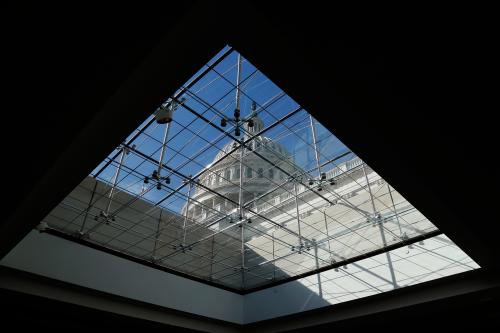 U.S. Government & Politics Minimizing debt ceiling crises: Principles and practical advice
U.S. Government & Politics Minimizing debt ceiling crises: Principles and practical advicePhilip A. Wallach
October 21, 2015
To Fix the Debt Ceiling, Executive Order not Obama’s Best Option 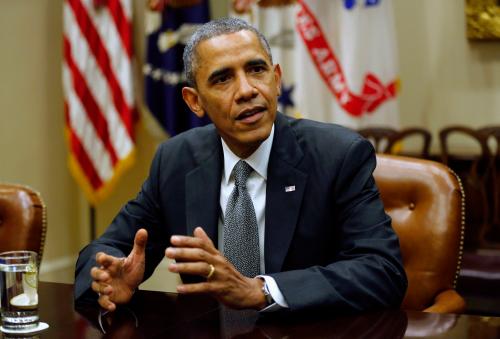 U.S. Government & Politics To Fix the Debt Ceiling, Executive Order not Obama’s Best Option
U.S. Government & Politics To Fix the Debt Ceiling, Executive Order not Obama’s Best OptionPhilip A. Wallach
October 15, 2013
An Opportune Moment for Regulatory Reform 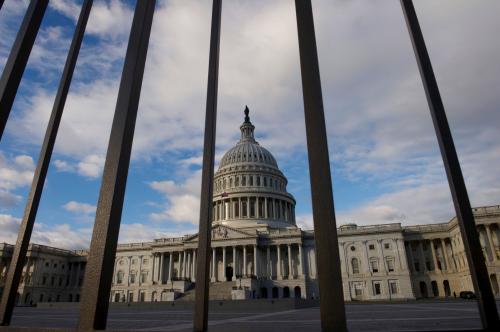 U.S. Government & Politics An Opportune Moment for Regulatory Reform
U.S. Government & Politics An Opportune Moment for Regulatory ReformPhilip A. Wallach
April 11, 2014
Related Books
The Road to War  U.S. Government & Politics The Road to War
U.S. Government & Politics The Road to WarMarvin Kalb
May 10, 2013
The Federal Budget  U.S. Government & Politics The Federal Budget
U.S. Government & Politics The Federal BudgetAllen Schick
June 1, 2000
It’s Even Worse Than It Looks: How the American Constitutional System Collided with the New Politics of Extremism 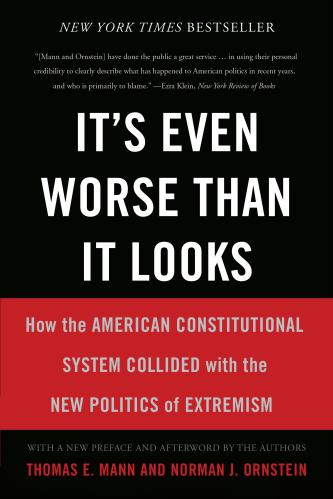 U.S. Government & Politics It’s Even Worse Than It Looks: How the American Constitutional System Collided with the New Politics of Extremism
U.S. Government & Politics It’s Even Worse Than It Looks: How the American Constitutional System Collided with the New Politics of ExtremismNorman J. Ornstein, Thomas E. Mann
September 3, 2013
The Brookings Institution is committed to quality, independence, and impact.
We are supported by a diverse array of funders. In line with our values and policies, each Brookings publication represents the sole views of its author(s).More OnProgramWhat is a government shutdown? 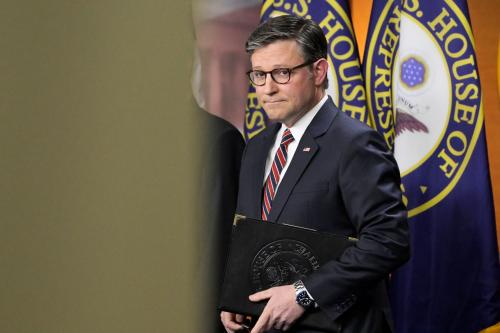 U.S. Economy What is a government shutdown?
U.S. Economy What is a government shutdown?David Wessel
November 14, 2025
Fiscal politics: The missing link between fiscal policy and gender equality  Sustainable Development Goals Fiscal politics: The missing link between fiscal policy and gender equality
Sustainable Development Goals Fiscal politics: The missing link between fiscal policy and gender equalityCaren Grown, Giulia Mascagni
November 13, 2025
Equal Rights Center v. Meta is the most important tech case flying under the radar  Courts & Law Equal Rights Center v. Meta is the most important tech case flying under the radar
Courts & Law Equal Rights Center v. Meta is the most important tech case flying under the radarDavid Brody
November 13, 2025


